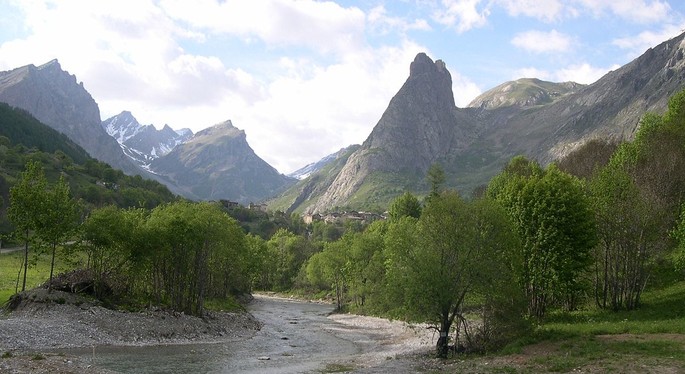Rugged and spectacular panoramas, forgotten and rediscovered villages. Crossing through Valle Maira, admiring the wonderful views and discovering the traditions, means taking a journey through time.
Valle Maira is a narrow piece of land located in the south of Piedmont, between France to the west and the Po Valley, just 45 km long and bordered by two massive mountain ranges and crossed by the Maira River.
Going up the mountain stretch of the Maira River from which the Cuneo valley, situated between Italy and France gets its name, signifies crossing an ancient sea that separated two continents millions of years ago. There are numerous stretches in which this deep geological transformation is evident and from which the Alps have been formed.
The landscape in Valle Maira is never taken for granted: in just 45 km, you go from lush oak and chestnut forests to deep canyons with plummeting vertical walls. This place is an authentic paradise for all those that love hiking and outdoor activities.
Sports enthusiasts have a wide choice of hikes, climbs, via ferratas and mountain bike trips.
Those who prefer their comfort, can go on car routes and walks to admire the wonderful views in the numerous lateral valleys, choose easy hikes, suitable for all the family, walk around ancient villages where the stone and wooden architecture has remained intact, visit ethnographic museums and the works of art of the Romanesque and Gothic churches and genuinely enjoy the sun, nature and the typical local cuisine.
Variety, relaxation and outdoor activities characterise summer holidays in Valle Maira, one of the wildest places of the Western Alps, where you can feel and breathe the thrill of the Occitan culture.
The whole valley was formed 300 million years ago, emerging from the depths of a prehistoric ocean as is proven by numerous prehistoric fossils. The ancient ocean that separated Africa and Europe closed in, leading to the collision of the two continents that caused the rising of the mountain range of the Alps.
There are numerous traces of this ancient geological reality: the vertical walls of Rocca la Meja or the contorted layers of the Punta Eco-Rocca Brancia group, the Cassorso and the Bodoira-Monte Giordano and Gardetta Plateau. Tracks, dated 245 million years ago of a group of Triassic reptiles, the Ticinosuchus Ferox, were found exactly on this plateau. These animals are similar to crocodiles, around 2 metres long, muscular, with a long tail that would have walked along the warm shores of the vanished ocean.
The "Natural Reserve of the Ciciu del Villar" has great geological relevance. In this location the so-called "Ciciu 'd pera" or "stone dolls", mushroom-shaped natural morphological sculptures, whose caps are glacial erratic and stalks are constituted by earth and crushed stone. These "columns" that rise at the foot of Monte San Bernardo are the result of a particular erosion phenomenon but popular tradition has it that they are Roman soldiers, transformed into stone to avoid being captured by San Costanzo.
The panorama of Acceglio is also of glacial origin, where reaching the village of Chiappera, the spur of Rocca Provenzale and Torre Castello can be admired, as well as the wonderful Stroppia waterfalls. To remain with the water theme, we cannot forget the Site of Community Importance where the Sources of the Maira are located; a place where water flows copiously into a glacial basin creating travertine caves, hidden by a dense forest of mountain pine.
During the advance of the ice, the relatively temperate climate of the Valley has also led to the specific evolution of flora and fauna. In this area, it is not rare to come across typical animals of the Asian steppes: the ptarmigan, the mountain hare, the black grouse, the stoat, and among plants, boxwood. Its particular geological origins, east-west direction of the mountains that protect it from cold northern winds, have enabled a unique microclimate to develop here that favours the development of numerous animal and plant species. It is not unusual while you are walking along the pathways of the valley to come across deer or chamois, hear the whistle of marmots and see a buzzard flying high in the sky.
Further Info: www.vallemaira.org/en/valle-maira/natura/


























![Hanbury Gardens, itineraries for everyone all year round [Videos] Hanbury Gardens, itineraries for everyone all year round [Videos]](https://www.italyrivieralps.com/typo3temp/pics/g_a7708c6a79.jpg)





